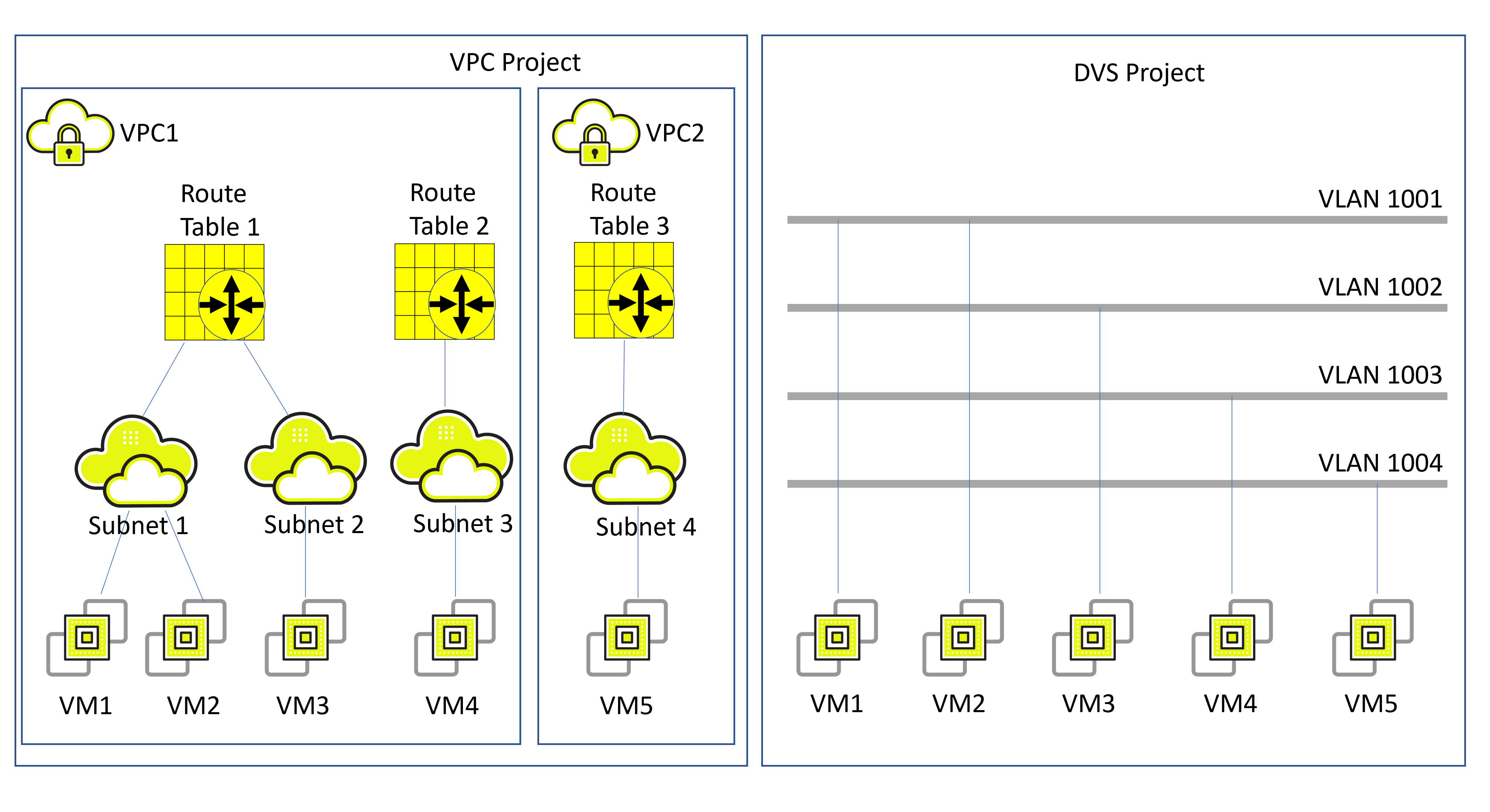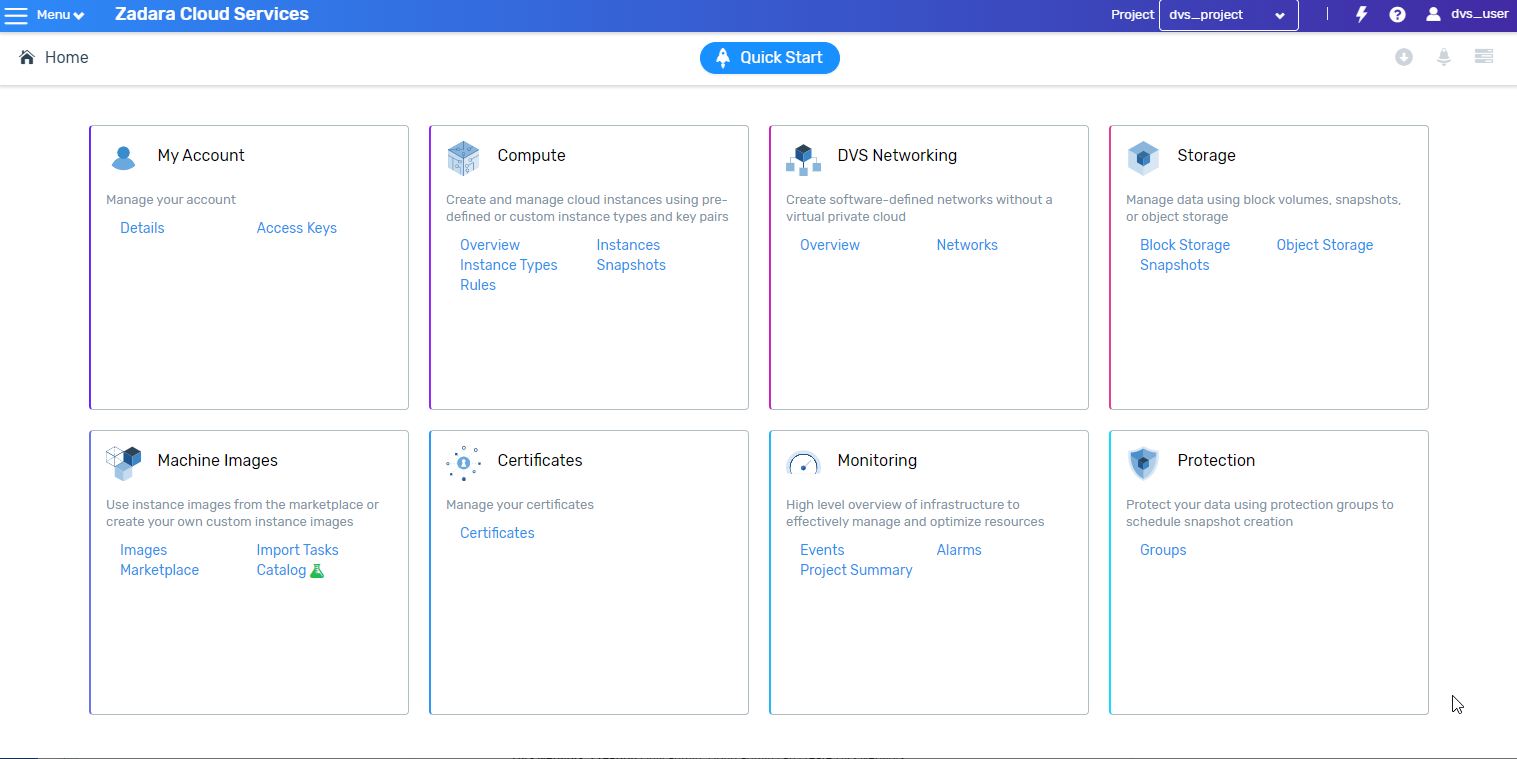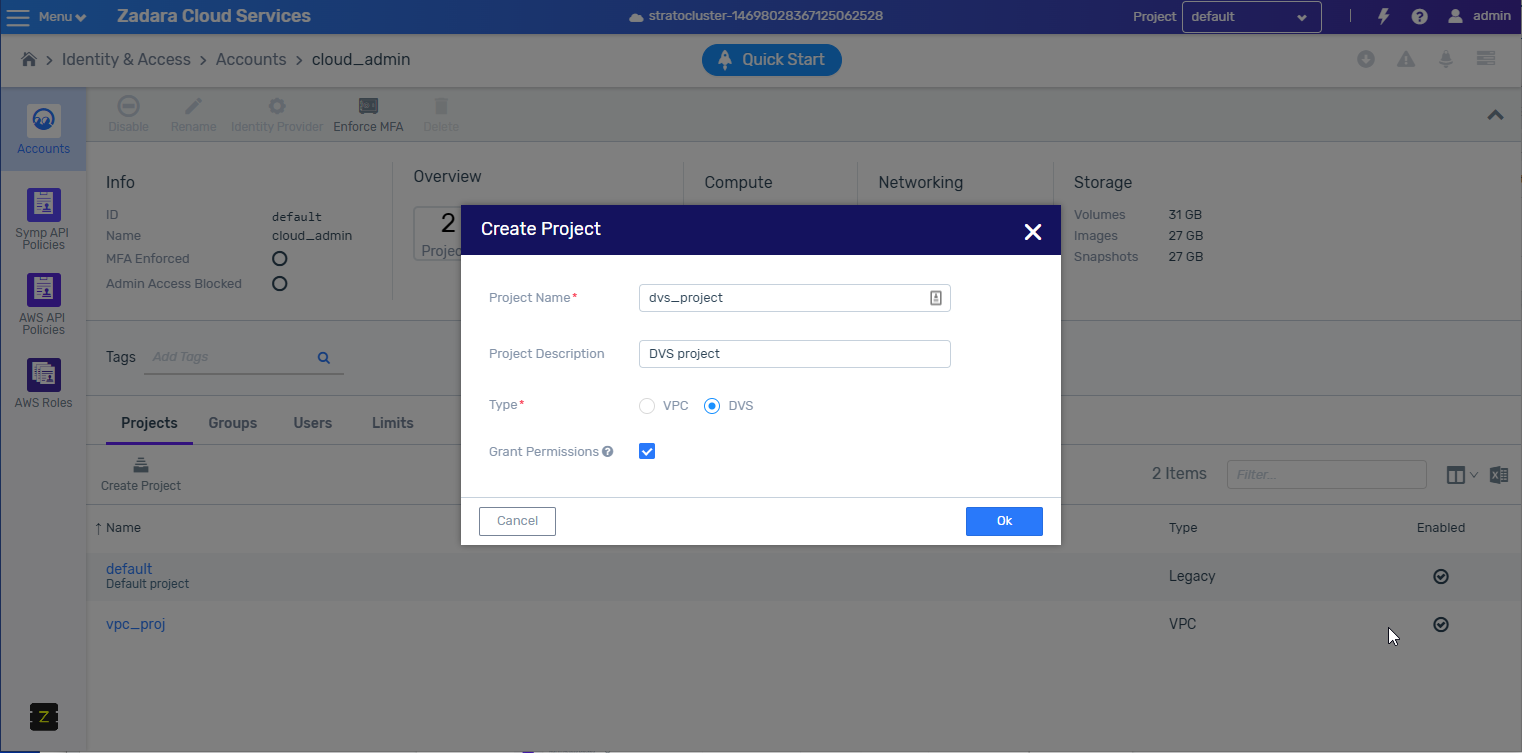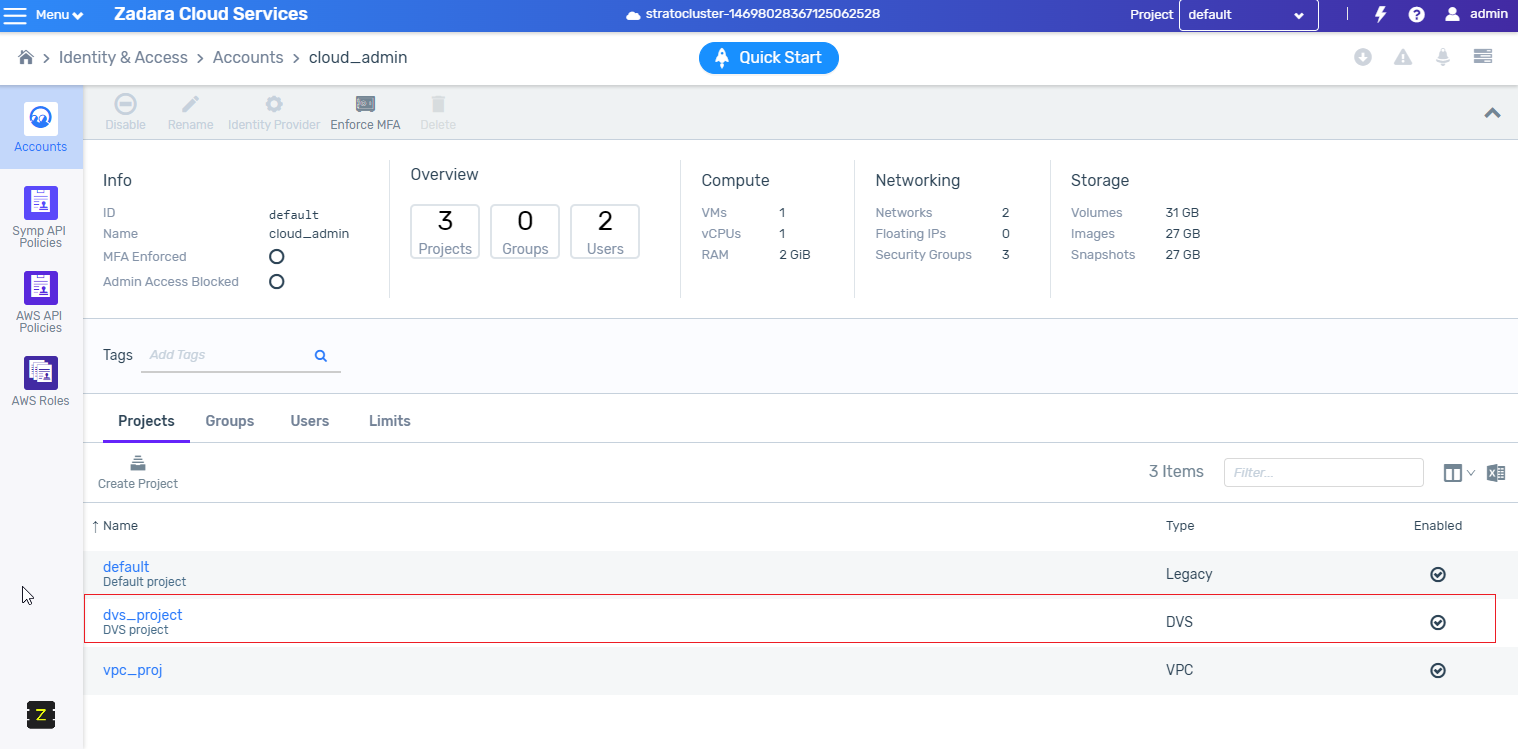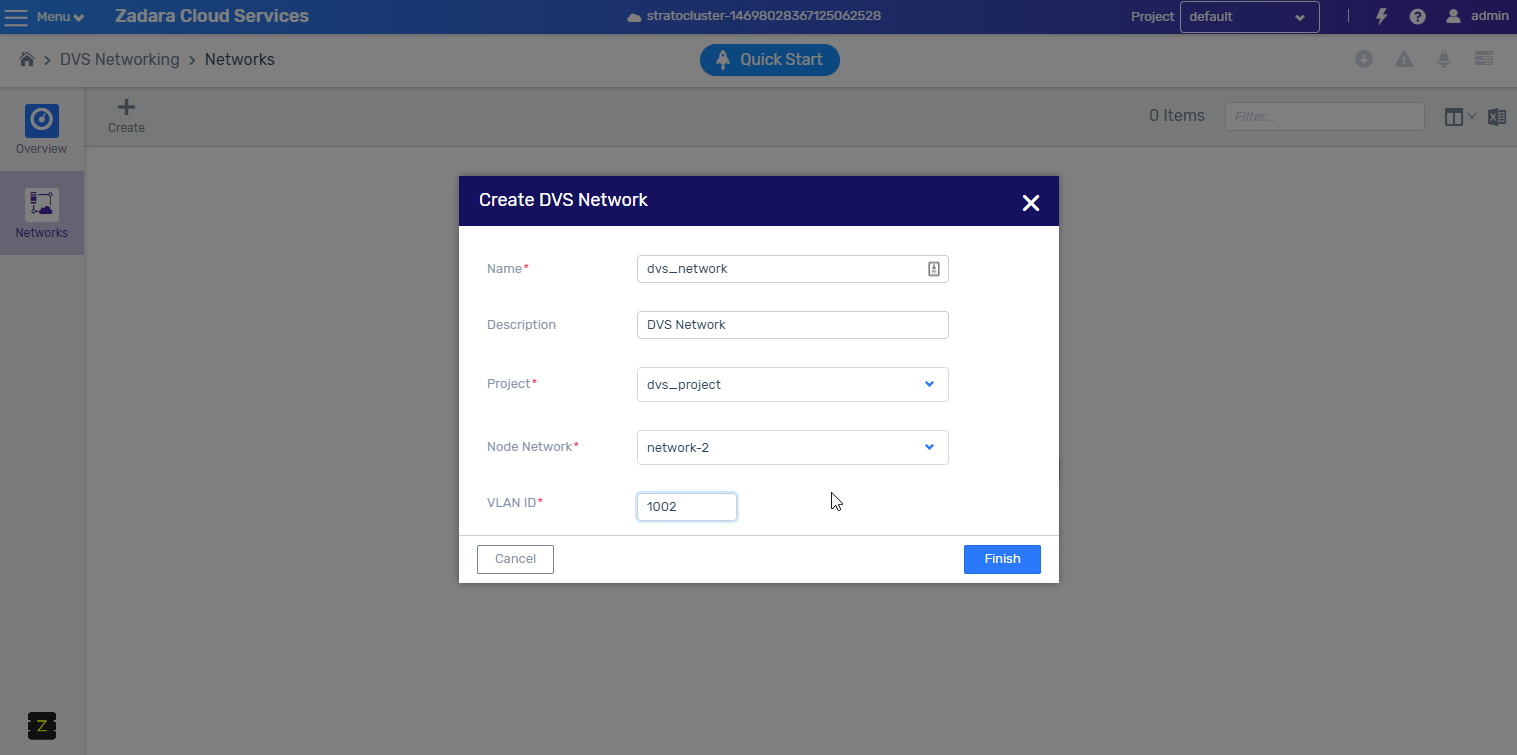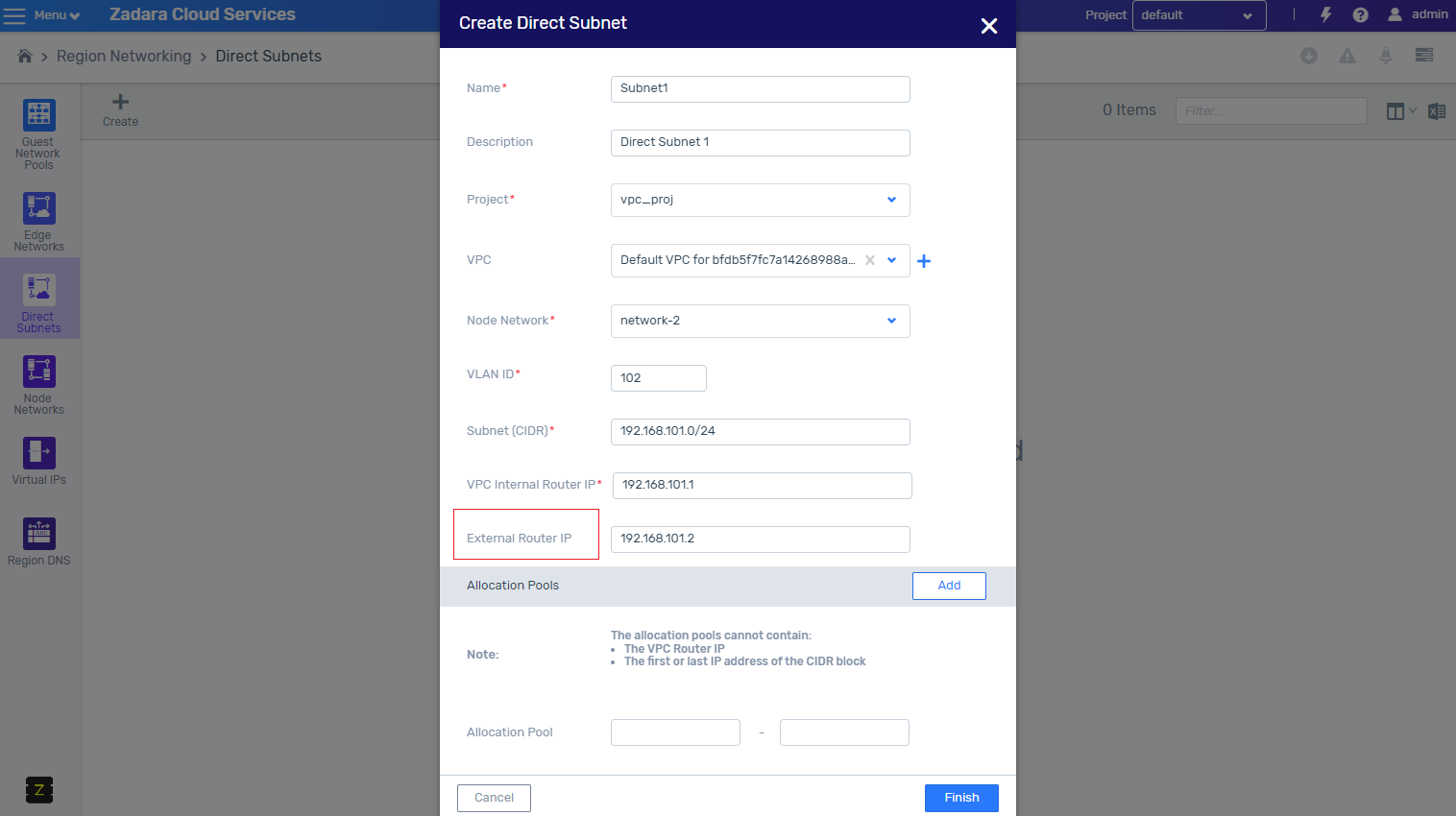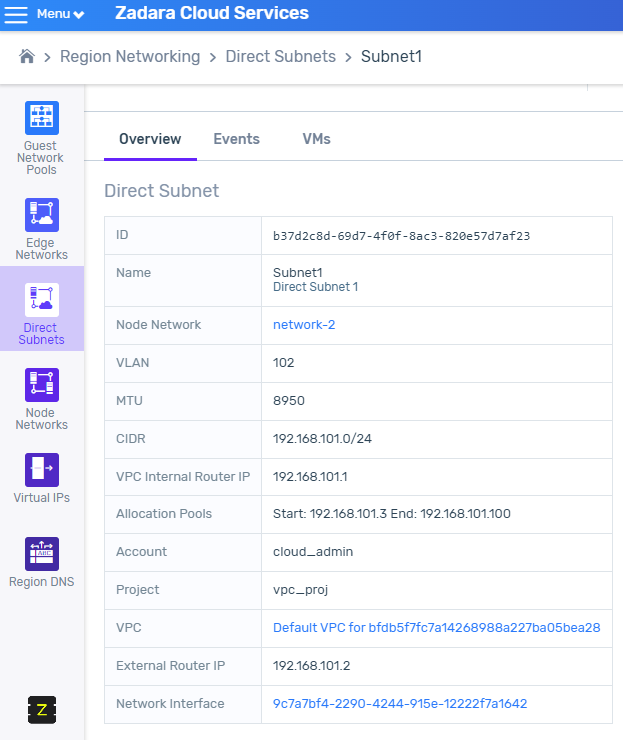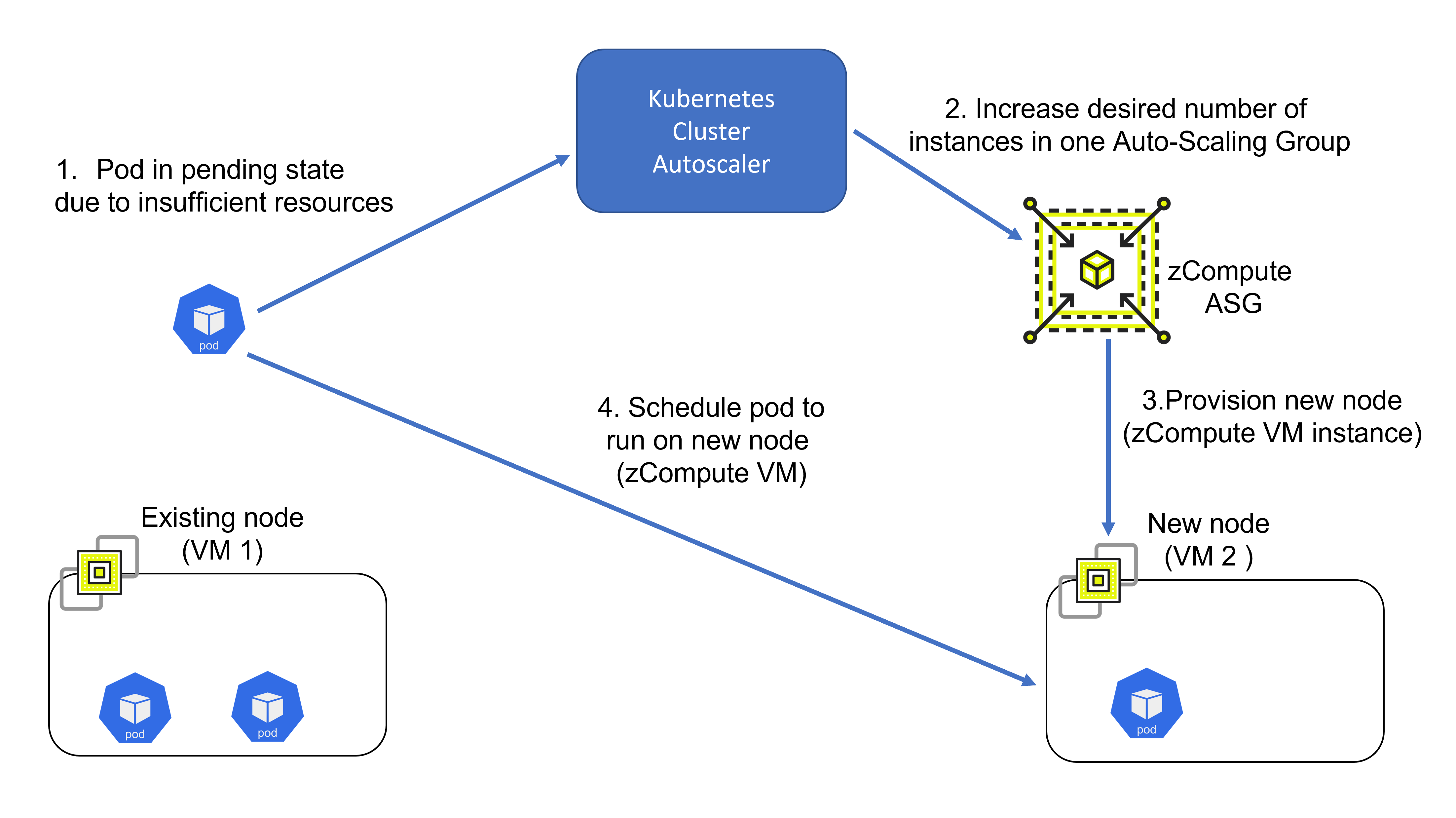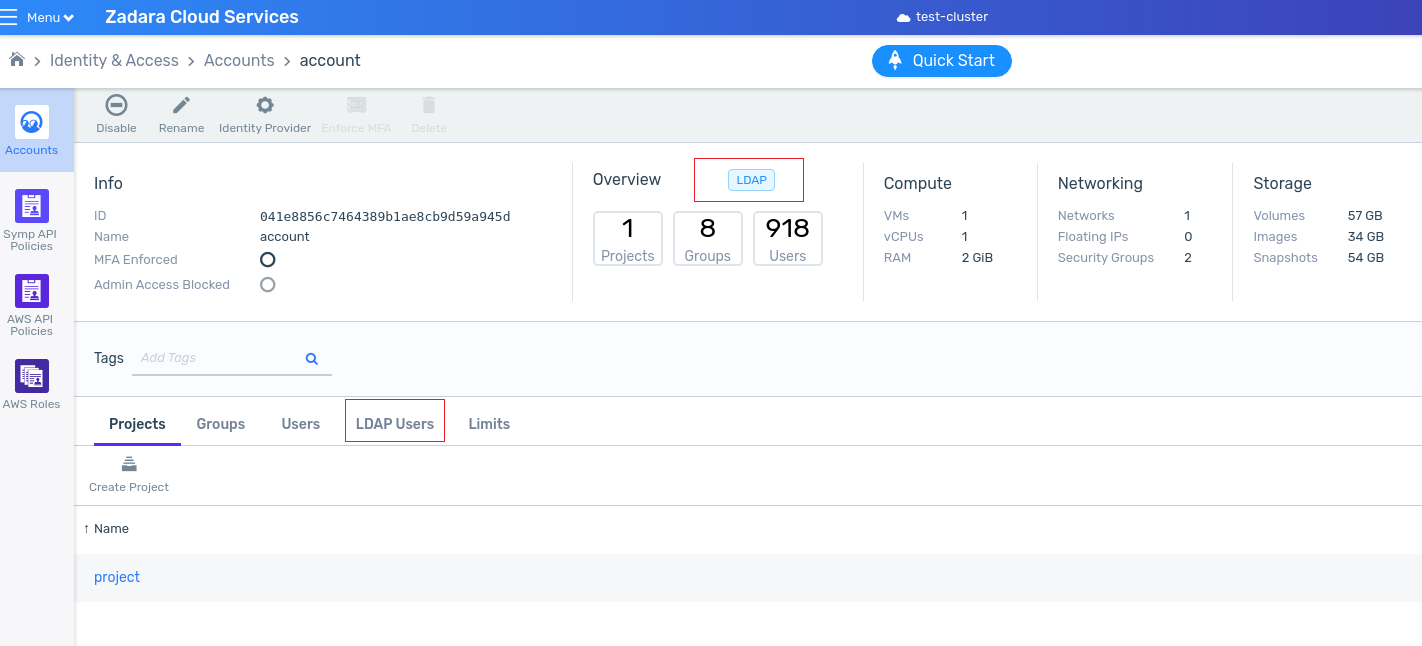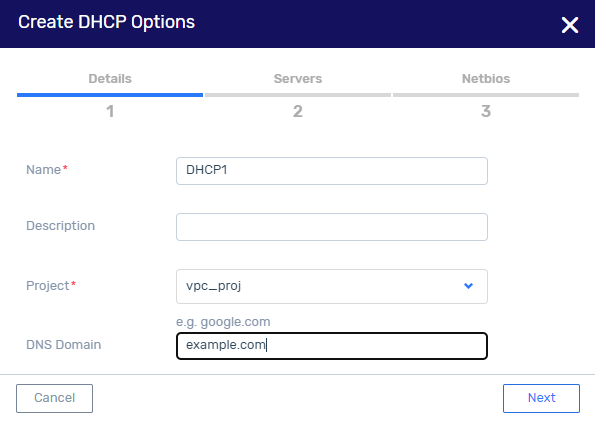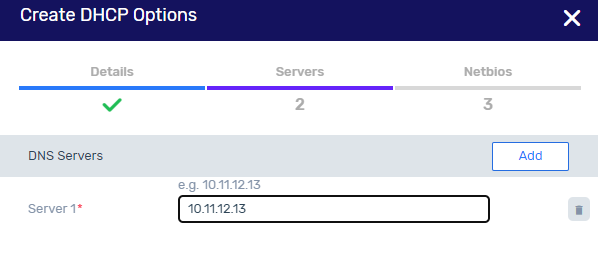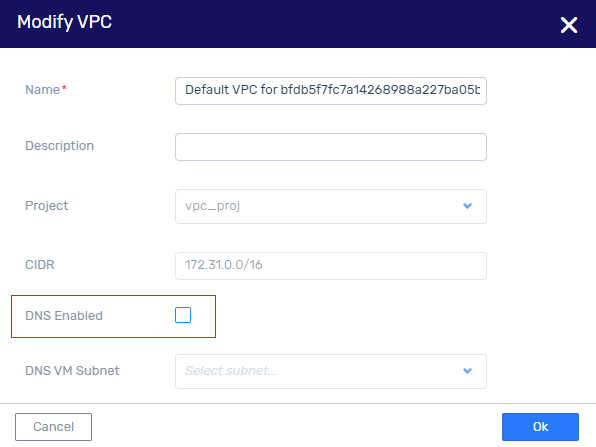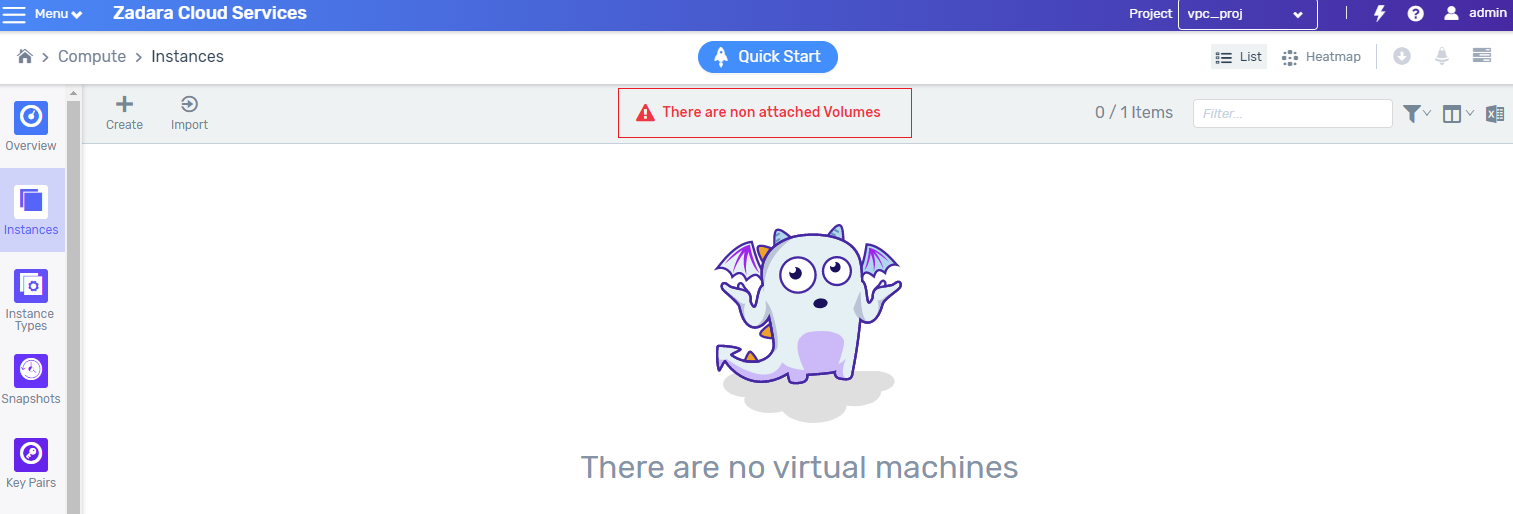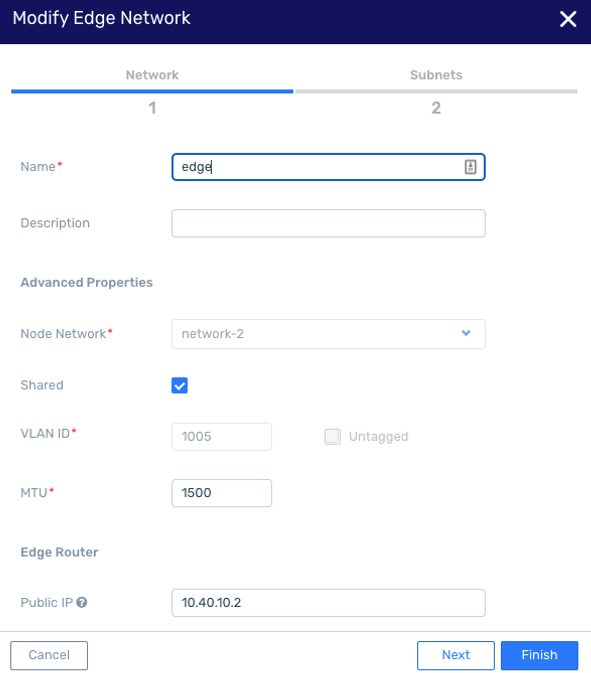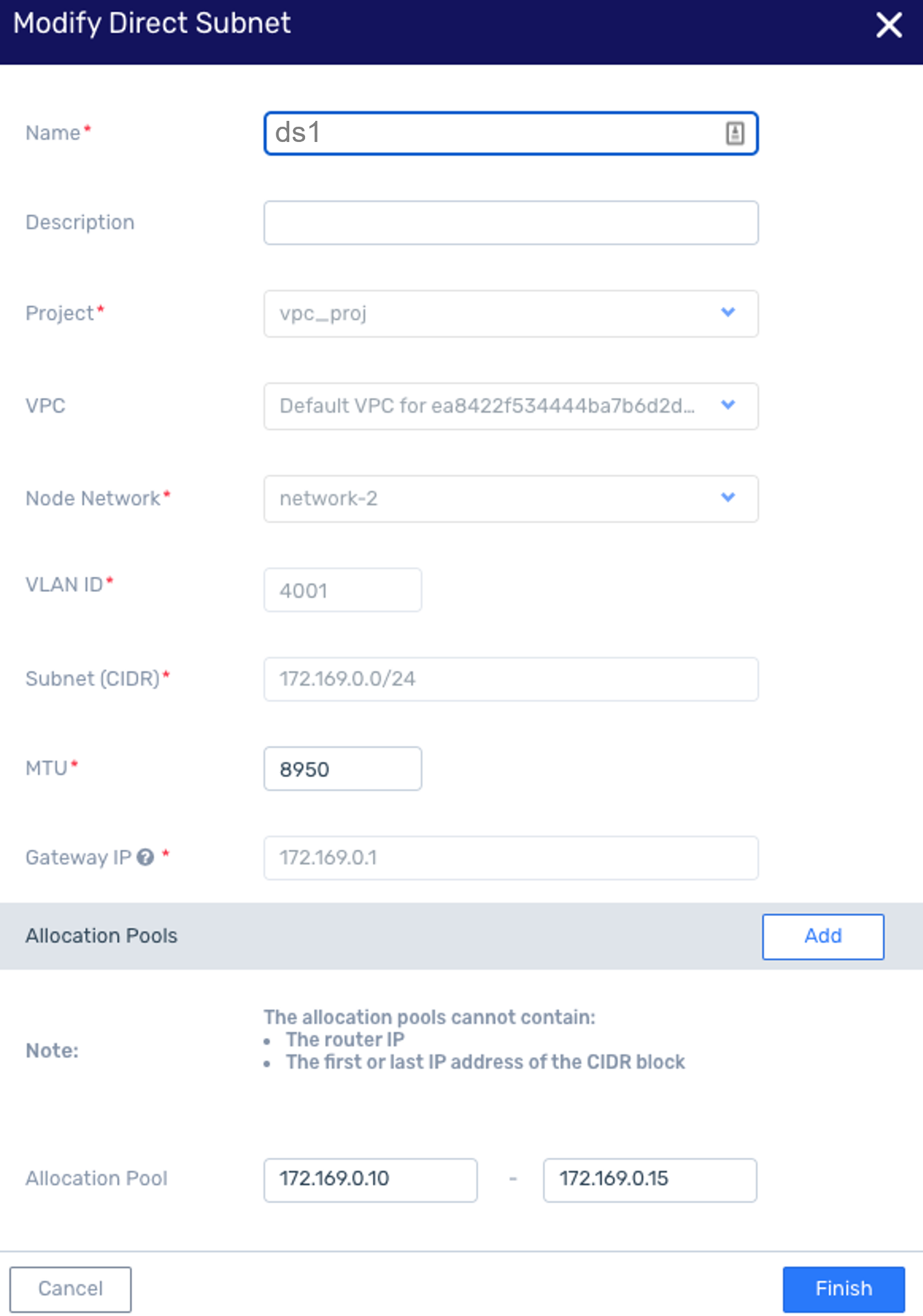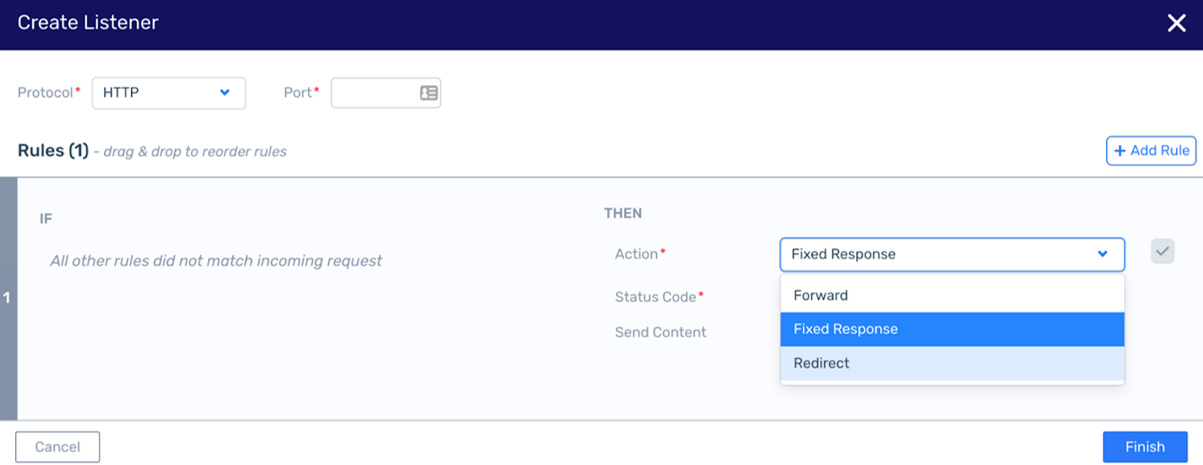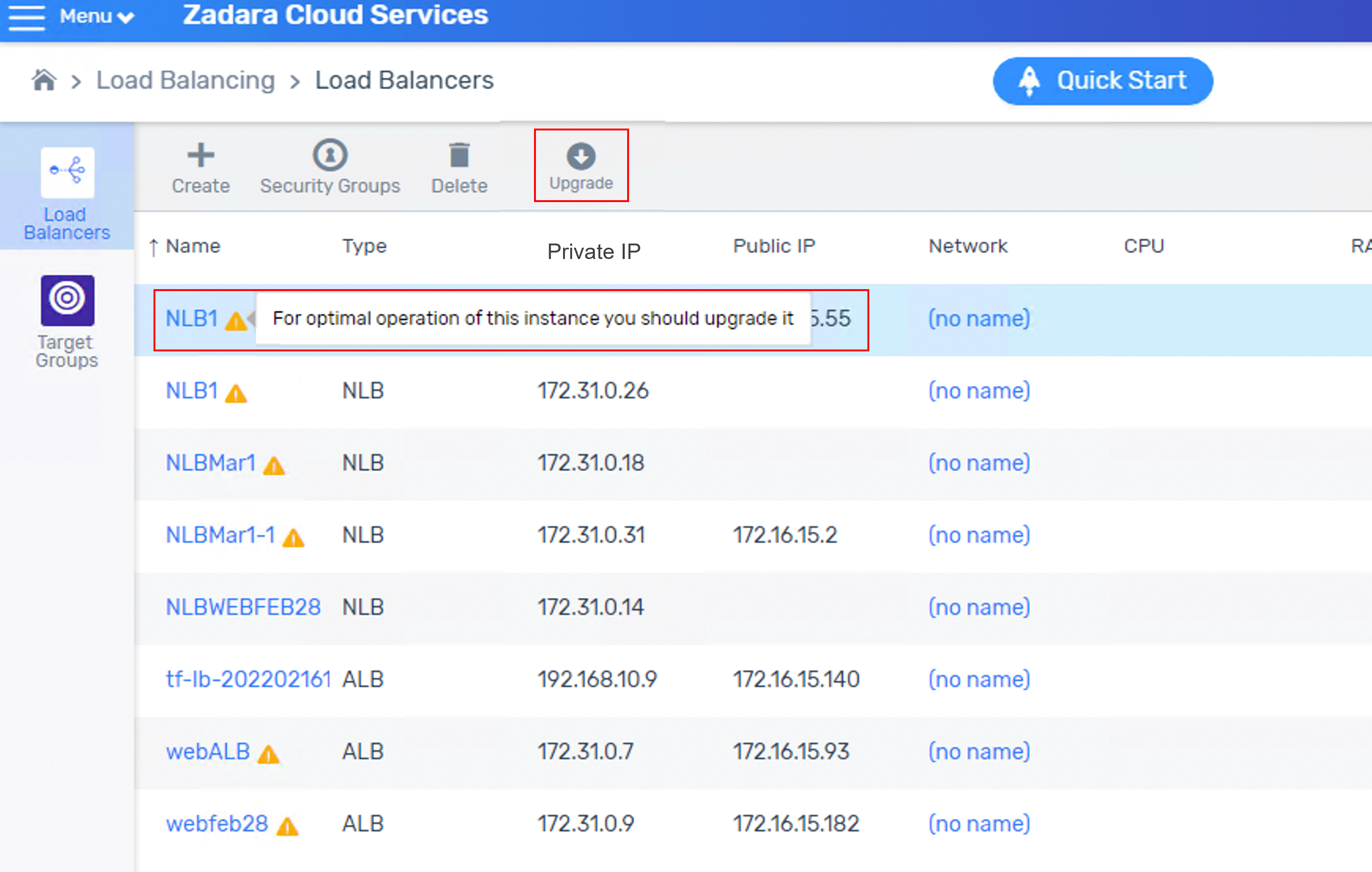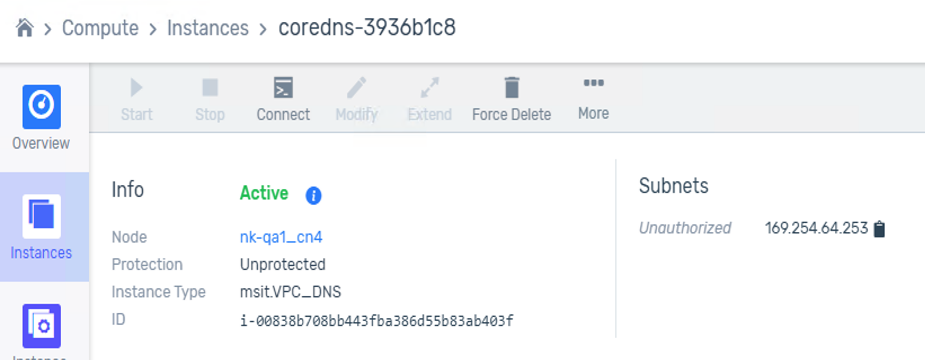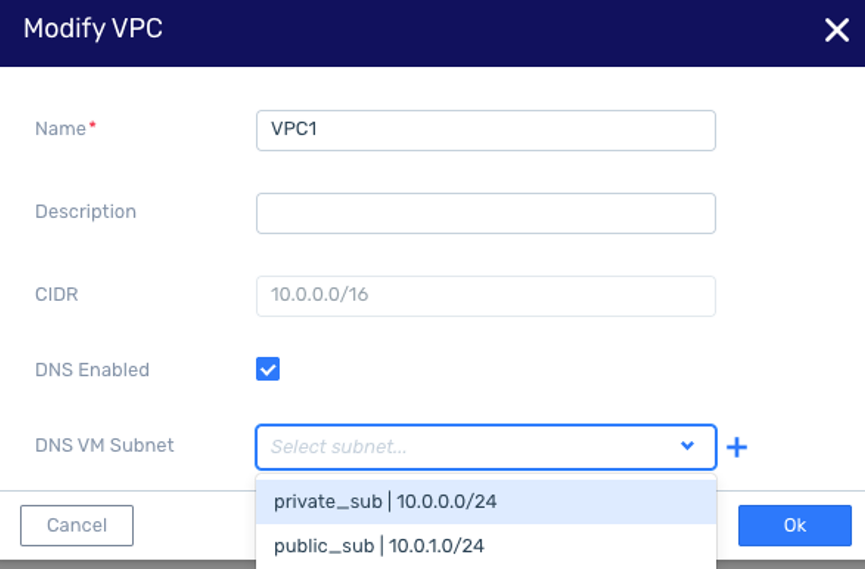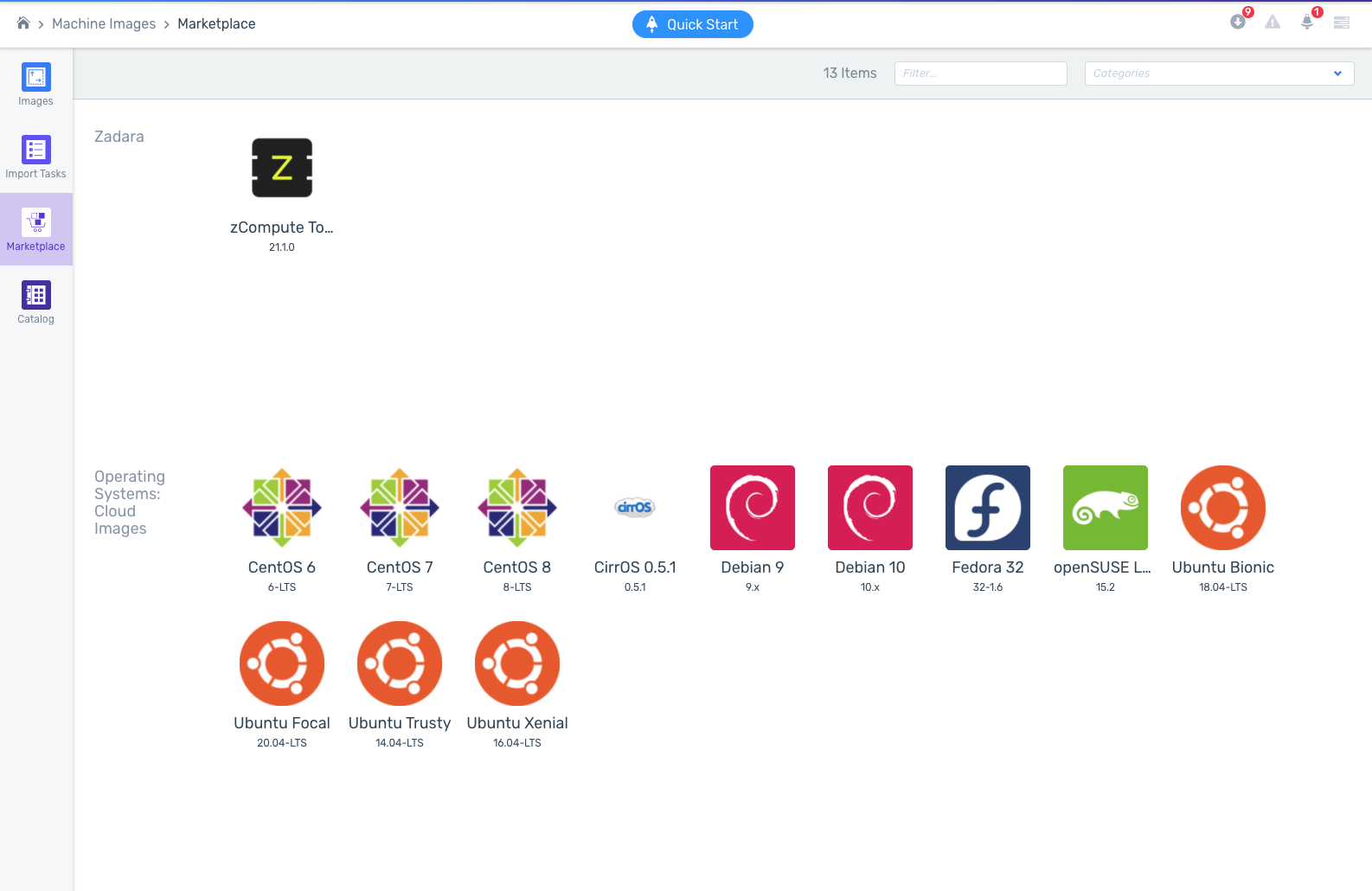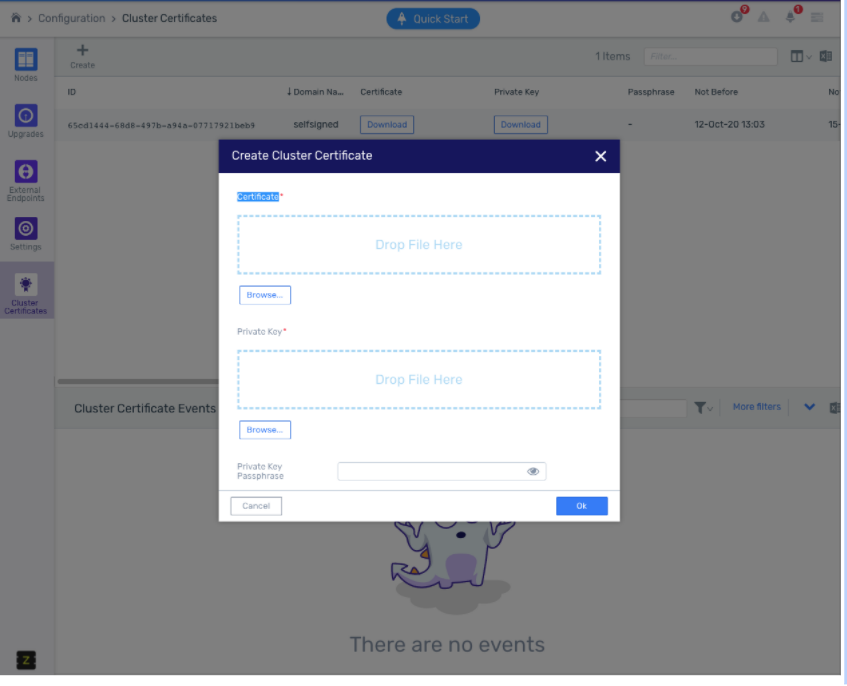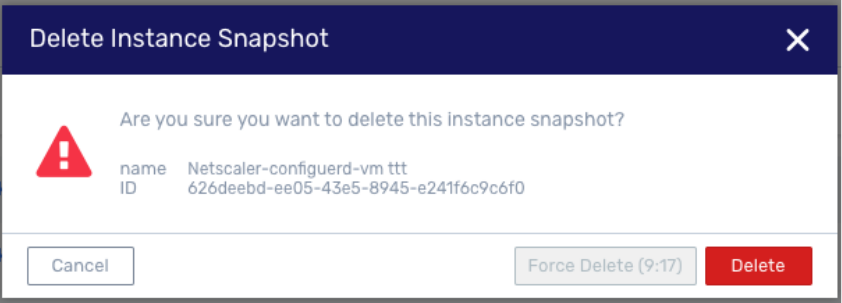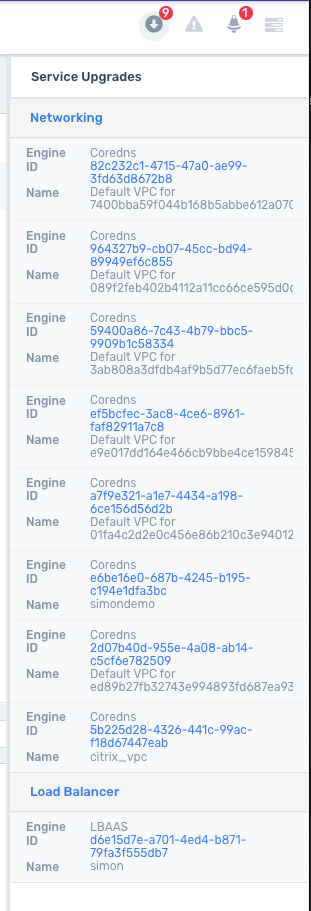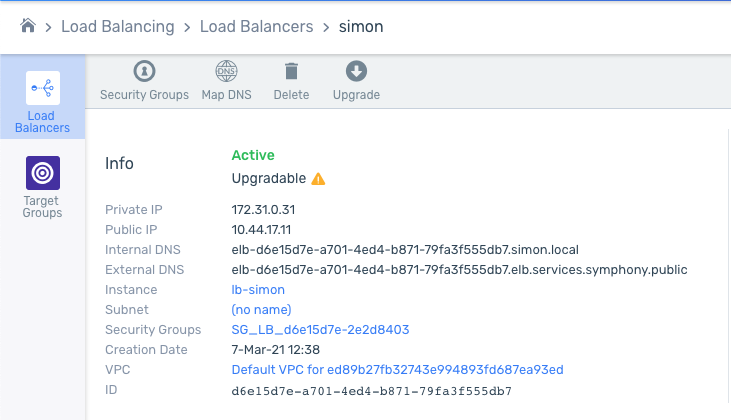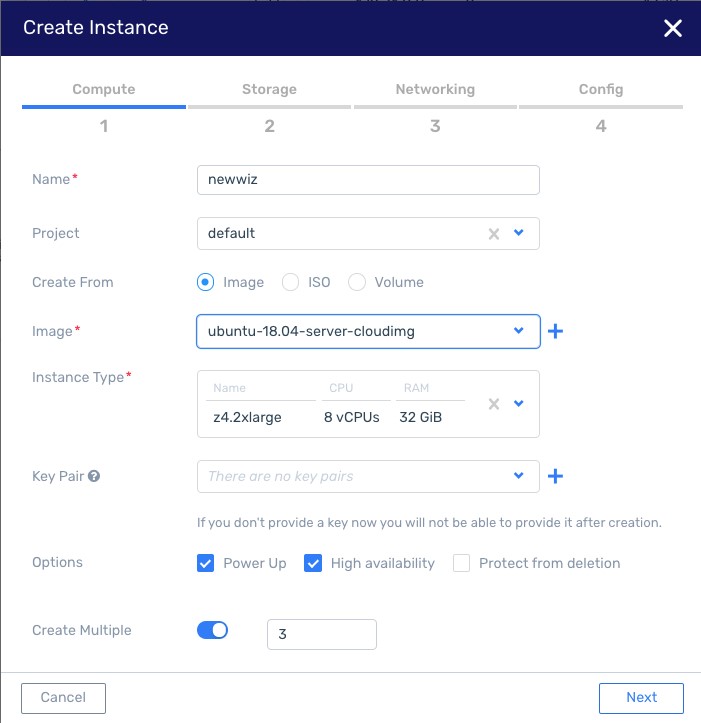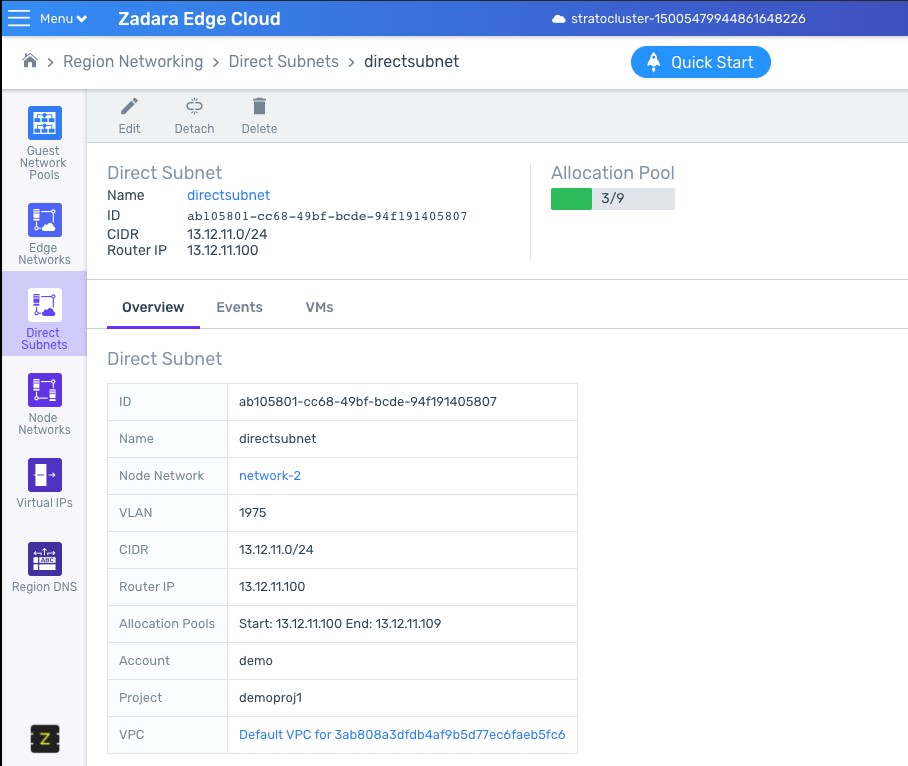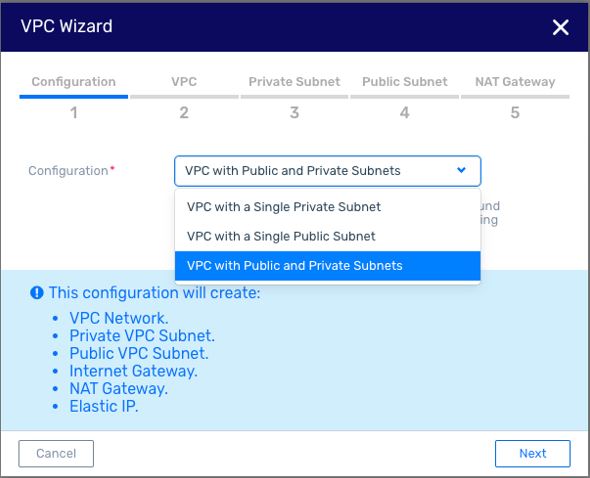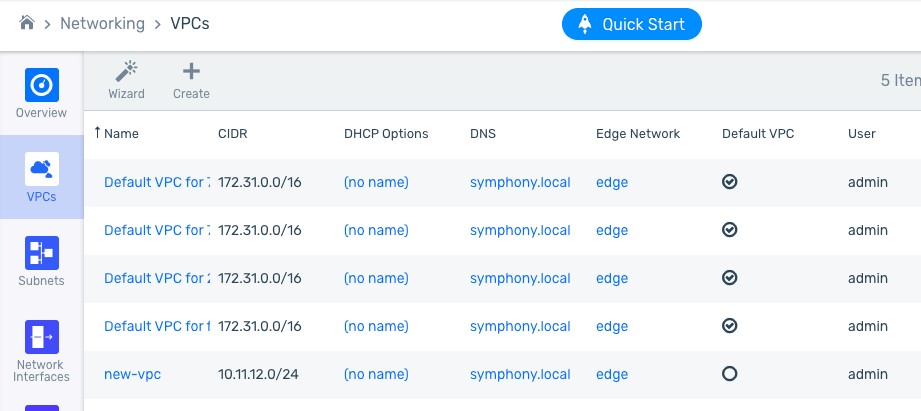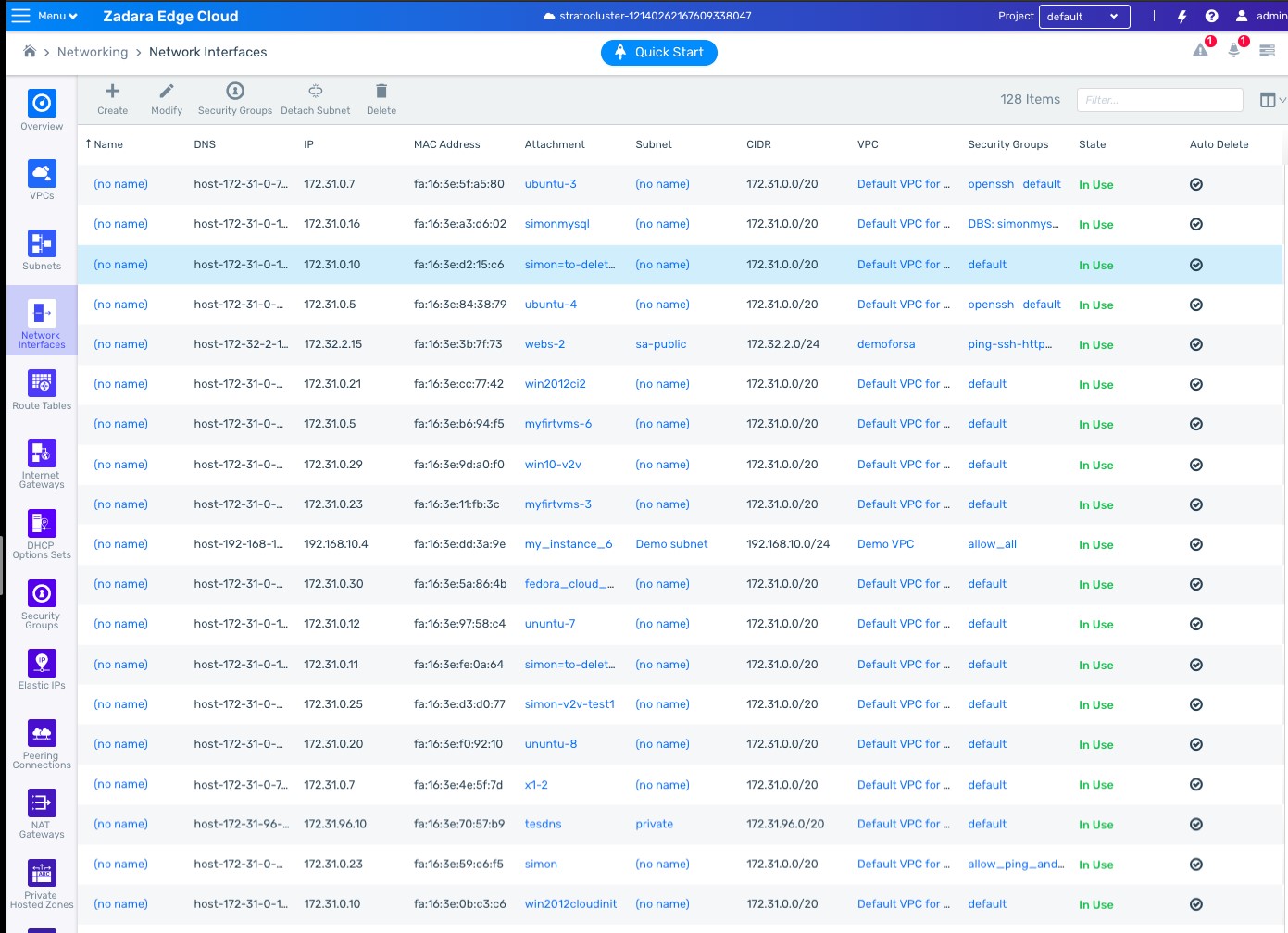Changelog¶
The following section will breakdown the additions and updates to the Zadara Compute Cloud platform (zCompute).
Version 24.03¶
Release 24.03 is a major version, that includes new features, scalability, security and usability improvements, and bug fixes.
It is highly recommended to upgrade to the latest version, to improve supportability.
For the purpose of planning an upgrade, see Supported upgrade paths.
Refer to Zadara End-Of-Support (EOS) policy and Releases support status.
For the main additions and updates to zCompute, see Key Enhancements.
Notable fixes¶
Version 24.03.0¶
The V2Z utility in Toolbox Fedora 2.3.5 includes the following fixes:
NK-11267
A V2Z migration case was discovered, where an invalid parameter resulted in a late fail.
This has been resolved with added initial validation checks rendering a fast fail when invalid.
NK-11575
V2Z preflight checks were failing for minimal permission users.
This has been resolved so that the V2Z preflight checks succeed for users with the minimal required permissions.
Version 23.08¶
Release 23.08 is a major version extended by service packs 23.08.1, 23.08.2, 23.08.3 and 23.08.4, that includes new features, scalability, security and usability improvements, and bug fixes.
Version 23.08.4¶
Taikun machine image in Marketplace¶
From version 23.08.4, the new Taikun image is downloadable from zCompute’s zCompute Machine Images Marketplace. This machine image provides an advanced managed Kubernetes service, with multiple cluster management from a single pane of glass.
Note
This image requires zCompute 23.08.4 (or later), and Volume types block storage.
For more information, see:
Video - Deploying & Managing Kubernetes Clusters & Applications on Zadara Edge Cloud with Taikun CloudWorks
For more information on Machine Images and the zCompute Machine Images Marketplace, see zCompute Machine Images Marketplace in the Compute Guide.
VPC Peering for Zadara Edge Clouds¶
From version 23.08.4, zCompute provides a pfSense machine image in the zCompute Machine Images Marketplace that enables routing network traffic between VPCs in separate zCompute clouds, using private IPv4 addresses.
This implementation uses IPSec technology for securing private connections between instances communicating with each other in a Zadara Edge Cloud.
For more information see VPC Peering for multiple Zadara Edge Clouds in the Networking guide.
VPN Service for Zadara Edge Clouds¶
From version 23.08.4, zCompute provides a pfSense machine image in the zCompute Machine Images Marketplace that enables remote access to a VPC.
The implementation uses OpenVPN technology for securing private connections between remote clients and Zadara Edge Cloud resources.
For more information see VPN Service for Zadara Edge Clouds in the Networking guide.
Version 23.08.1¶
Language support in zCompute UI¶
From version 23.08.1, the zCompute UI supports the following languages:
English (default)
German
Japanese
Korean
Portuguese
Spanish
For more information, see zCompute UI Language support in the Compute Guide.
Oracle Linux OS support¶
zCompute 23.08.1 has been extended to support the following OS types and versions for VM images:
Type |
Distribution |
Version |
|---|---|---|
Linux |
Oracle |
7 |
Linux |
Oracle |
8 |
Linux |
Oracle |
9 |
For other supported OS types and versions for VM images, see New OS types and versions.
ECDSA key support¶
From version 23.08.1, zCompute supports use of ECDSA keys for VMs. It is possible to import and successfully use a public key in SSH or RSA (PEM) formats.
Known issues and limitations¶
For Windows password recovery (Get Windows Password dialog), the UI only accepts keys in RSA (PEM) format.
In version 23.08.0 and earlier, zCompute does not accept keys for VMs in SSH formats, but only in RSA (PEM) format.
Toolbox Fedora 2.3.1¶
The new Toolbox Fedora 2.3.1 VM is available in the zCompute UI’s Machine Images > Marketplace. This is a Fedora VM that includes the option to migrate VMware VMs, using the V2Z migration utility. See Migrating VMware VMs to zCompute in the Compute Guide.
Tag support in Subnet creation¶
From version 23.08.1, zCompute supports the addition of tags in a Subnet creation operation. See Creating a Subnet in the Networking Guide.
This is useful mainly with Terraform and auto-deployments with EKS-D.
Version 23.08.0¶
Packaged zCompute EKS-D image¶
EKS-D is Amazon’s open-source implementation of its Elastic Kubernetes Service (EKS).
zCompute 23.08 provides customers with the ability to deploy and use the prepackaged Kubernetes solution in zCompute clusters.
The zCompute EKS-D image is downloadable in the zCompute UI at Machine Images > Marketplace.
The zCompute 23.08 EKS-D solution is verified, and certified by Kasten (acquired by Veeam). Thus, zCompute 23.08 can also provide a backup, recovery and migration solution for Kubernetes over zCompute.
For more information and examples, see the EKS-D README in Zadara’s examples repository in GitHub.
Distributed Virtual Switch (DVS)¶
Distributed Virtual Switch (DVS), is a zCompute networking model which provides layer 2, VLAN-based networking functionality for VMs running on zCompute.
The idea behind DVS is to provide customers who are more familiar with legacy virtualization platforms (for example, VMware, Hyper-V, Nutanix, etc.) with a networking environment similar to the simplified networking model found in such legacy environments.
DVS provides simple OSI layer 2 VLAN-based switched networking functionality for VMs. DVS networks can be used to interconnect VMs attached to them, as well as for connecting these VMs with other network entities that reside in the hosting data center (servers, routers, storage devices, etc.).
The DVS model provides physical switching L2, VLAN-based connectivity, whereas VPC provides a rich IP networking platform (route-tables, subnets, security groups, Internet gateways, DNS, Elastic IPs, etc.) alongside other cloud-native services that are independent of physical switching configuration, such as auto-scaling groups, load-balancers, etc.
Zadara zCompute supports both VPC and DVS networking modes in coexistence: A single zCompute account (tenant), can have multiple VPC-based projects alongside DVS-based projects.
DVS was introduced in zCompute 22.09.
In version 23.08, the DVS infrastructure was enhanced with improved
management of VLANs for the purpose of creating guest networks.
Cloud admins allocate VLANS to an account’s VLAN pool.
Tenant admins can allocate VLANs from the account’s VLAN pool to a DVS project
pool.
Member-role users can now create VLAN-type guest networks by allocating
VLANs from a DVS project’s VLAN pool.
For more information about DVS, see Distributed Virtual Switch (DVS) in the Networking Guide.
Migrating to a DVS project¶
VMware VMs that are migrated to zCompute using the V2Z migration process result in VMs in a rich VPC networking type project, rather than in the simpler DVS networking alternative.
Tenants who prefer the simpler DVS networking model can further migrate their newly migrated zCompute VPC VMs to a DVS project.
To migrate VMs to a DVS project, see Migrating a VM to a DVS project in the Compute Guide.
Volume types¶
From version 23.08, zCompute simplifies storage management with volume types that provide users with a range of options to meet their storage requirements, balancing factors such as performance, cost, and specific workload demands.
By abstracting the underlying storage infrastructure, volume types simplify storage management and allow users to focus on selecting the appropriate type for their zCompute needs.
Different volume types offer varying levels of input/output operations per second (IOPS) and throughput, which determine the storage performance.
VM Instance Types¶
VM instance types are templates defining the resources used by a VM instance. A VM’s instance type is determined by selecting one of the permitted types, during the creation flow of the VM instance.
zCompute 23.08 has been enhanced with support for a large number of new Zadara instance types.
Note
New custom instance types can only be created after receiving Zadara approval, and after getting pricing.
Amazon instance types are available as aliases, mapped to the closest zCompute instance type. VMs created with Amazon instance types display their Instance Type as the zCompute Instance Type, and the Amazon instance type as the VM’s Instance Type Alias.
For more information, see Instance Types in the Compute Guide.
VM network interface, Route Table, and Network Reset¶
zCompute 23.08 introduces soft and hard reset support for VM network interfaces, route-tables and networks.
A soft reset rebinds all ports, and is available to admins, tenant admins and members.
A hard reset resets the service, and is limited to admins and tenant admins.
In the Networking Guide, see:
VPC DNS status reporting improvements¶
In zCompute 23.08, the UI is enhanced with detailed VPC DNS status information, with key benefits such as:
Reducing time to resolve VPC DNS issues
Logging events of CoreDNS VM status and DNS health status changes
When DNS is enabled for a VPC, its DNS VM status and DNS health status are checked once per minute and reported for the VPC.
See VPC DNS status in the Networking Guide.
Instance Profile¶
An instance profile is a container for an AWS IAM role. It can be used to pass role information to an EC2 instance when the instance starts. When an AWS IAM role, embedded in an instance profile, is attached to an instance, its credentials become permanent.
In zCompute 23.08, the UI has been enhanced with support for Instance Profile management (IAM Guide), and implementing instance profiles in the Config tab of Creating VM Instances (Compute Guide).
API Audit Trail for Admin/Tenant-Admin¶
zCompute 23.08 has been enhanced by a security auditing feature, and provides API capability for integration with 3rd-party solutions. Admins and tenant admins can query API calls logging POST, PUT, PATCH and DELETE calls for a 60-day retention period.
See api-trail in the Symp CLI reference.
Note
Sensitive information, such as passwords, tokens, secret access keys, IODC client secrets, metadata and user data in VM metadata are excluded from the logging and audit.
VPC Endpoint¶
From zCompute 23.08, a VPC endpoint allows a VM to access the system APIs using an internal VPC IP address.
The API is available on the internal IP addresses 169.254.64.2 and 169.254.64.3, assuming that the cluster has more than 2 nodes. The system also provides a DNS record resolvable to these IPs when the VPC DNS service (coredns) is up, and a valid certificate is installed.
The DNS name:
When a valid certificate with a wildcard CN is used, the DNS name is:
cloud.<parent-domain>.For example, the DNS name for CN
*.example.comiscloud.example.com.When a valid certificate with a regular CN is used, the DNS name is the same as the CN.
For example, the DNS name for CN
test.example.comis alsotest.example.com.
The cluster’s DNS name is returned in the cluster_url property of the
VM’s metadata response. For example, for a cluster with a certificate with
the CN *.example.com:
curl -s http://169.254.169.254/openstack/latest/meta_data.json | jq -c .cluster_url
"https://cloud.example.com"
Note
For new VPCs, the update of the DNS records is immediate.
For existing VPCs, the update of the DNS records can take up to 24 hours.
GRE traffic over EIPs¶
From zCompute 23.08, Generic Routing Encapsulation (GRE) traffic over Elastic IP addresses (EIPs) is supported.
GRE Tunneling is a tunneling protocol that encapsulates network layer protocols inside virtual point-to-point links over an Internet Protocol network. The tunnel source and tunnel destination addresses on each side identify the two endpoints. GRE packets travel directly between the two endpoints through a virtual tunnel.
GRE via NAT gateways - known limitation¶
GRE via Network Address Translation (NAT) gateways is not supported.
VM BIOS auto-reboot¶
Until zCompute 23.08, there was an issue of Windows VMs getting stuck after BSOD and reboot, due to no boot device available at the time of the restart.
zCompute 23.08 delivers an enhanced configuration for the VM’s BIOS to keep auto-rebooting the VM if no boot device is found after 10 seconds.
Note
After auto-reboot is applied on a cluster, a maintenance window must be planned and scheduled for stopping and restarting the VMs, for the auto-reboot to take effect.
New OS types and versions¶
zCompute 23.08 has been extended to support the following OS types and versions for VM images:
Type |
Distribution |
Version |
|---|---|---|
Linux |
Alma |
9 |
Linux |
Alma |
Other |
Linux |
Rocky |
9 |
Linux |
Rocky |
Other |
Linux |
Debian |
11 |
Linux |
Fedora |
34 |
Linux |
Fedora |
35 |
Linux |
Fedora |
36 |
Linux |
Fedora |
37 |
Linux |
RHEL |
9 |
Linux |
Ubuntu |
22.04 |
Windows |
Windows Server |
2022 |
V2Z utility improvements¶
The V2Z utility supports easy migration from supported virtualization platforms to zCompute projects.
In zCompute 23.08, the V2Z utility has been extended to support VM Instance Types and Volume types instead of storage pools.
V2Z custom instance types - known limitation¶
In the V2Z utility, custom instance types are not allowed for most users.
Security¶
In zCompute 23.08, an updated zCompute Toolbox Fedora image (version 2.3.1) has been released with enhanced security hardening. The Toolbox image is downloadable in the zCompute UI at Machine Images > Marketplace.
Notable fixes¶
Version 23.08.4¶
NK-10748:
A rare edge case was discovered that could theoretically cause a data corruption.
This was resolved despite the unlikely probability of it occurring in any current production implementation.
Version 23.08.3¶
NK-9822:
Fixes related to ASG behavior:
Cases were reported where scaling up or down stopped after an upgrade.
VMs rebooted during an LCS upgrade.
These issues are resolved.
NK-9297:
VSC migration failed due to an error calculating reserved capacity limits. This is resolved.
NK-9638:
The api-trail was accumulating high volume of events before clearing them. This is resolved, so that garbage collection is triggered according to event count or time interval, whichever is reached first.
NK-9967 and NK-10039:
Japanese and Korean localizations in the UI are updated with corrections.
Version 23.08.1¶
NK-8656:
For tenants that have LDAP configured, the only local zCompute user account that should be usable is the tenant admin account (for break-the-glass scenarios.) In a rare case that was discovered, when the LDAP disconnected, the local tenant admin was unable to sign on. This is now resolved.
Version 22.09¶
Release 22.09 is a major version extended by service packs 22.09.1, 22.09.2, 22.09.3 and 22.09.4, that include new features, scalability, security and usability improvements, and bug fixes.
The following section will breakdown the main additions and updates to the Zadara Compute platform (zCompute).
AWS ELB-compatible APIs in zCompute¶
Previously, zCompute’s LBaaS supported one certificate per listener.
From release 22.09.4, zCompute supports multiple TLS / SSL certificates for a single listener on the same TCP port servicing HTTPS. This feature is currently supported in Symp and AWS API. It will be introduced into the zCompute UI at a later date.
Large Cluster Systems (LCS)¶
With this version of Zadara zCompute, Zadara takes a leap into new use cases that require much larger clusters at the Edge. To support larger applications, especially data analytics, a new deployment topology was added that allows for 75 physical nodes and upwards (exact numbers to be published in the future). Until now, the maximum official cluster size was 16 nodes, with engineering exceptions for specific customers to extend to 24 nodes. This is referred to as the standard configuration.
Note
Any standard configuration cluster can be transformed into an LCS.
The transition from an LCS back into a standard configuration is not supported.
Moving to an LCS cluster requires a minimal cluster size of 16 nodes, and three additional nodes that serve as control nodes. Control nodes can’t be used to run instances. This has an impact on the floor, but not on the instance pricing. Zadara’s solution architect will recommend whether to use the standard or LCS configuration per system, based on customer needs.
Distributed Virtual Switch (DVS) mode¶
Release 22.09 introduces a new simplified network model which gives our customers the ability to place virtual machines (instances) directly on a VLAN-based mode which extend to the data center switches. This is similar to other common data center virtualization solutions, (such as VMWare, HyperV, etc.).
Essentially, tenants can regard DVS mode projects as a single virtual switch with uplinks to the data center switches. Tenants see networks that are set up by the cloud admin, and when choosing to create a network interface for the VM on the network, the system automatically adds them to a VLAN-tagged port on the virtual switch.
A network in a DVS mode project represents a VLAN-tagged L2 network. The VLAN tag itself is hidden from the users. It’s the admin’s choice whether to disclose the VLAN tag ID to users via the network name or description. VMs will get a network interface with a MAC address, but without an IP. Tenants may assign an IP address manually or via a DHCP server (connected to their physical network).
Differences between VPC mode and DVS mode projects:
Cloud admin capabilities¶
Admins can create a project in DVS mode.
Admins can create a VLAN-based network providing the VLAN tags. Note that the VLAN tags provided must match the physical switches configuration in the data centers (tagged ports, etc.).
When creating a zCompute account for tenants, the default project is a VPC project. Tenants that require a DVS project must open a ticket to Zadara Support or to their MSP system admin to create a DVS project and the desired networks.
Note
Since most of the system services and networking capabilities of zCompute depend on zCompute controlling the IP stack, these services are not available for projects in DVS mode. The following services will be disabled:
EIPs
Routers
Advanced services, such as DNS, NAT Gateway, LoadBalancers, Auto-scaling groups etc.
AWS API (Terraform is not supported)
Marketplace is available, but cloud machine images that make use of Cloud-init and Cloudbase-init won’t work
DVS project overview¶
DVS projects have limited features and options in the tenant UI:
DVS project and network creation¶
DVS project and network creation are restricted to admins only, and are included here solely for informative and completeness purposes.
DVS - known issues¶
NK-3898: On DVS projects, users are not able to set project level tagging that later propagates to virtual machines. Workaround: Once the VM has been created, users can navigate to the VM and add the tag.
NK-4598: The DVS instance tab shows the key pair option while restoring the snapshot backup, even though key pairs are not supported in this version.
NK-4606: The DVS networks overview displays a warning message to clear the filters, even though no filter is applied. Click
Clear Filtersto display the overview.
Direct subnet external router¶
A direct subnet is an IP subnet in a VPC that spans out of a zCompute system over a VLAN to the datacenter network. Direct subnets allow communication between physical-network and VPC entities, for example, VMs within a VPC connected to a VPSA.
In many cases, the tenant may provide a data center router for VMs in the VPC, including VMs attached to the direct subnet, to access data center subnets that are not on the direct subnet.
Until now, there was a workaround that required manually creating a network interface to represent the external router, so the user can set the proper routes in the VPC route tables. Now the administrator can add the IP of the external router during the creation of the direct subnet, and the system will be able to route to this router.
The system now creates the ENI that can be used for routing rules, making it easy to add a route towards an external network using ENI.
Note
It is important to note that even though the route seems explicit to an IP, upon update of the external router IP, the system automatically creates a new ENI with the new IP, and updates the route in the route tables.
Auto-Scaling Groups: Added missing compatibility with AWS API¶
This version supports the Cluster Autoscaler in Kubernetes setup through the zCompute Auto-Scaling Groups. Cluster Autoscaler is a tool that automatically adjusts the size of the Kubernetes cluster when one of the following conditions is true:
There are pods that failed to run in the cluster due to insufficient resources. In this case, zCompute ASG provisions a new node (zCompute VM instance), and schedules the failed pods to run on it.
There are nodes (zCompute VMs) in the cluster that have been underutilized for an extended period of time, and their pods can be placed on other existing nodes (zCompute VMs).
Cluster Autoscaler utilizes zCompute Instance Auto-Scaling Groups to manage node groups. Cluster Autoscaler typically runs as a deployment in your cluster.
LDAP self-service enhancement¶
This version supports LDAP self-service. Tenants who wish to use their LDAP to login to their account can now set up their own LDAP connection without opening a ticket to Zadara Support to do it for them.
As part of the self-service, the account now supports a “local”/”Break glass” tenant-admin that can configure and enable the LDAP connection.
All other users should come from LDAP.
LDAP users can’t add more local users or groups. Only the local tenant admin user is allowed to do so.
How to connect LDAP to your tenant account¶
Note
Prerequisite: The system must have a route to your LDAP server. If the LDAP server is located outside of your account and the system has no access to it, contact Zadara Support for assistance.
Log into your account as tenant admin.
Click the “Identity Provider” and follow the instructions to fill in the details.
zCompute also enhanced the user lists. Now, the lists are split into tabs:
Users: list of local users.
LDAP Users: list of LDAP users.
Protect admin password change¶
Admin users won’t be able to set a new password for themselves using the
user update API. This is to prevent someone from hijacking an open
session and changing the password without knowing the old password.
If admins want to change their own password, they can use the
user change-password API, that requires them to provide the old
password in order to proceed with the change.
Disabling the VPC DNS allows direct connection to the tenant DNS¶
In a Microsoft Active Directory (AD) environment, the AD maintains the DNS and VMs cannot use the VPC DNS. With this feature, tenants can provide the AD DNS to the Windows VMs via the DHCP protocol.
When using zCompute in VPC mode with a VPC DNS service enabled, the instances are configured to access the internal VPC DNS which serves as a caching DNS for external resolvers, in addition to adding the VPC entries. In this mode, VMs can’t be auto-registered to the external DNS. This specifically impacts Windows AD environments, where virtual machines are registered to the domain DNS while joining the domain.
Until now, disabling the VPC DNS only disabled the VPC level DNS, but still provided a subnet level DNS. The only solution for Windows domain DNS was to statically configure the Windows OS to point to the domain DNS instead of the value provided by zCompute DHCP server.
Now, when disabling the VPC DNS, the name server entries added to the DHCP options will be passed directly to the VMs, so they can stop using the workaround.
Steps:
UI now warns about volumes that are not connected to any VM¶
As with many other cloud services, there are many scenarios when deleting a VM that data disks are not deleted with the VM, since volumes are entities that at any given time may be detached from one instance and connected to another. Volumes can also be detached from the VM and remain in the account as long as needed.
In some cases, customers forget to delete volumes after deleting the VMs, and then are billed at the end of the month. To avoid surprises, the system now informs when there are unattached volumes, so that customers may go and delete them if they were not intentionally kept.
Possible scenarios where volumes remain unattached:
Using the APIs, and forgetting to delete the data volumes after deletion of the VMs.
Using Terraform, and Terraform encountered a failure during the teardown process.
Using the GUI to delete a VM or multiple VMs, and forgetting to delete their data volumes.
Volumes that are not connected to any VM - known issue¶
NK-4242: ‘Default volumes’ are impossible to delete. We are experiencing difficulties in deleting what appear to be “non attached volumes”. Although the UI does not show the attachment, the volumes are still attached to the host.
Enhanced remote DNS status validation¶
Until now, the validation only checked that the name server provided to the VPC DNS is responding to queries. Now there is a validation that the DNS can resolve a known destination (default is google.com).
If the provided DNS server can’t resolve this well-known address, the DNS is reported as degraded.
Enhanced remote DNS status validation - known limitations¶
The DNS status for VPCs without a valid route to an IGW will always be “Degraded” when the default DHCP option with the google DNS is used.
If tenants set their own name server in the VPC’s DHCP options, and their name server is unreachable via the VPC gateway or it can’t resolve google.com, the VPC state will degrade.
Ubuntu 22.04 LTS image in Marketplace¶
Release 22.09.2 provides the Ubuntu 22.04 LTS OS image for download from the zCompute Marketplace.
To download the image, in the UI go to Machine Images > Marketplace.
Enhanced support utilities¶
This release contains enhanced utilities allowing Zadara Operations to improve maintenance automation flows, time to resolution of incidents, and to take more proactive measures to prevent incidents. It is highly recommended to upgrade to this version to improve supportability.
Notable fixes¶
NK-6332: zCompute’s AWS-compatible
DescribeNetworkInterfacesAPI returned thestatus=in_use(with an underscore) instead ofstatus=in-use(with a hyphen). This has been resolved, in alignment with the AWS status value.NK-6498: An edge case was discovered where a user created incorrect values for DHCP options that caused the DNS to stop working. This has been resolved with a fix, preventing creation of incorrect values for DHCP options.
NK-3744, NK-3928: Fix for Windows clock offset In previous versions, virtual machine migrations sometimes caused time changes in the guest. This is now fixed. In order for the fix to apply, users must set the Windows OS type in the VM properties, or use a Windows image for which the Windows OS type has already been set.
Security and non-functional fixes¶
NK-4847, NK-4848, NK-4406, NK-4785, NK-5238, NK-5293: Some minor security and non-functional issues were resolved.
Version 22.02¶
Release 22.02 is a major version extended by three service packs (SP1, SP2 and SP3), that includes scalability, security, usability improvements, new features and bug fixes.
The following section will breakdown the main additions and updates to the Zadara Compute platform (zCompute).
Premium instance types¶
Zadara now offers premium instance types based on Intel Gen 3 Platinum 8362. Please contact sales for more information.
NVMe instance types¶
Zadara now offers instance types with NVMe based on the premium types. Please contact sales for more information.
Note
NVMe storage is a local passthrough device, meaning:
VMs using NVMe disks cannot be migrated for maintenance.
NVMe devices are ephemeral.
Zadara only offers complete NVMe devices and does not partition a device between VMs.
SAML SSO Support¶
Limited availability of SAML SSO support, for large installations. Please contact Zadara ops/sales, if required.
New zCompute Toolbox Fedora image including the V2Z utility (from Version 22.02-SP2)¶
A new zCompute Toolbox Fedora version is available. It includes the following changes:
Moved from CentOS 7.9 to Fedora 36.
User changed from Centos to Fedora.
New Symp client, compatible with Fedora.
Now comes pre-installed with the V2Z tool for VMWare/Hyper-V VM imports.
No default login user. Instead use the cloud-init procedure to change the user password
Known issues:
NK-3835: The zCompute Toolbox Fedora shows the old version for members in the Marketplace. This means that tenants will still continue to download the older version if using the Marketplace. Instead look for a pre-downloaded image in the image list. If it’s not there, please ask Zadara ops or your cloud administrator to download it for you and make it publicly available in the system.
NK-4055: zCompute Toolbox Fedora is missing the Symp offline pip dependencies. This means that the python dependencies installation requires you to be online (internet) when running symp-update.
Load Balancer API¶
Added compatibility with AWS fixed-response and redirect action types.
Control over VPC subnet MTU¶
Users can now view and change MTU values per virtual network.
- The relevant networks are:
Edge networks (for MSP administrators only)
Direct networks(subnets)
VPC subnets
The minimum allowed MTU value is 1450 for standard VPC subnets or 1500 for direct subnets or edge networks.
The maximum allowed MTU value depends on the global MTU configured in the cluster (e.g. 9000 or 1500). If the global MTU configured in the cluster is 9000, the maximum allowed MTU value for all virtual networks will be limited to 8950.
If a VM experiences MTU related connectivity issues and it resides on a public network (connected via a route-table to an internet-gateway), then it is recommended to set that network MTU to no more than 1500.
LIMITATION: It is not possible to create a direct subnet in the GUI with desired MTU. However, the MTU can be updated post-creation.
Note
This feature only changes the MTU as reported to the user VMs via DHCP, it does not change the actual MTU of the virtual network. VMs that use MTU value from DHCP will be updated only after the DHCP lease is renewed.
New Load Balancer Service Version¶
In order to support Kuberenetes integration with the managed load balancer service, the functionality and APIs were enhanced to support fixed-response and redirect action types that are compatible with their AWS equivalents.
Fixed-response: Return a custom HTTP response
Redirect: Redirect requests from one URL to another
An example terraform script that create a Kuberenetes cluster that uses zCompute APIs for persistent volumes and a load balancer service type is available at: https://github.com/Neokarm/neokarm-examples/tree/master/k8s.
Known issues:
NK-2921: Getting an Action Failed status when trying to create a listener in the ALB on an cluster upgraded to version 22.02-SP1, but with the previous LBAAS engine.
Workaround: Upgrade the LBAAS engine before creating a new load balancer.
NK-3247: zCompute officially supports Terraform 2.47. Terraform AWS Provider versions higher than 3.33 fail on LBAAS ARN validation.
Important
The new action types are applicable only after a cluster is upgraded to version 22.02.1, and then the load balancer engine is upgraded.
After your zCompute account has been upgraded, all new load balancer instances will be created using the new engine image. The upgrade of already running load balancer instances is opt in. Users should upgrade their existing load balancer in order to receive the new functionality.
The new load balancer target-group types (fixed-response, redirect) in older images are not supported and require upgrade.
Creating DNS VM in any VPC network (from Version 22.02-SP2)¶
In this release, Zadara introduces the option for the user to select the subnet range to create a CoreDNS within a specified subnet range. This will allow accessing the CoreDNS VM from outside the VPC when using a VPN or VPC Peering, and forward DNS requests to it.
By default, the DNS is created with IP address 169.254.64.253, which is only routable inside the VPC.
In this release, the user will have the option to select from which of the VPC subnets to allocate the DNS IP.
Users can modify a VPC and switch the VM DNS Subnet. This operation is mutli-step operation: First disabling the DNS, then changing the VPC network, and finally re-enabling the DNS. The GUI does this sequence automatically, so it is recommended to use the GUI for this operation.
Custom policies support¶
IAM admins and tenant admins can now upload custom symp and AWS policies and then apply them to users, using the new symp APIs or AWS API.
Known issues:
NK-3786: Terraform is not supported at the moment, since it uses a the AWS CreatePolicyVersion API, which is not supported.
Creation of a new policy is only available via APIs and not from the GUI. Once the new policy has been created, the admin can apply it to users using the GUI.
Fixes (Versions 22.02-SP2 and SP3)¶
Versions 22.02-SP2 and SP3 each include a collection of minor fixes.
Notable fixes (Version 22.02-SP1)¶
NK-2374: Fixed sporadic slow response times on volume operations.
NK-2767: Fixed an issue with Windows VM sometimes hanging on migration.
NK-2814: Fixed an issue with no connectivity between VMs with EIPs and other VMs with EIPs on the edge-network subnets. Effectively this meant that VMs between different VPCs could not connect over elastic IPs without Zadara ops intervention.
NK-3144: Fixed issues on local routes delete in route tables, usually leading to UDP packets stop working after removing their elastic IP.
Notable fixes (Version 22.02)¶
There is limited availability of version 22.02, and it should not exist anymore in the field. All changes are listed under version 22.02-SP1.
Version 21.12¶
Release 21.12 is based on the 21.10 version. The version includes various core changes in order to significantly improve the guest operating system performance (primarily Microsoft Windows).
Version 21.10¶
Release 21.10 is a major release which includes scalability, security, usability improvements, new features and bug fixes.
The following section will breakdown the main additions and updates to the Zadara Compute platform (zCompute).
Support multiple subnet ranges for Elastic IPs¶
It is now possible to add multiple non-contiguous subnets to the same Elastic IP pool. Each may have its own gateway. This is aligned with the way site operators purchase public IP ranges. As part of the change Zadara added the following enhancement:
The ability to add multiple subnet ranges to the same Elastic IP pool
Each subnet may have its own default gateway
Virtual Routers will not consume Public IPs anymore, instead a single public IP will serve the entire edge network. This IP is required to access external name servers.
Current limitations:
Implicit DNAT Functionality is deprecated and will stop working in one of the next releases. This means: a VM without an EIP will not be able to reach an external destination. If such a flow is required, customers should use the explicit NAT GW service to implement this functionality. Also note that certain OS (e.g. Ubuntu, Windows) configuration for Zeroconf will overlap and interfere with the edge routers subnet address range - VM using DNAT cannot access VM using EIP.
Can’t retire a subnet from the edge network without removing all the EIP from this subnet that is in use by instances. The Edge network DNS servers that are configured for the edge network must be accessible from all edge subnets If multiple edge subnets are configured, then all of them must be configured with the same DNS servers. configuring different DNS servers for different subnets will cause unexpected behavior
These features require additional upgrade procedures for existing VPCs as external connectivity will be temporarily disrupted.
Site operators, for more info please contact Zadara support
CentOS 8 has been added to the zCompute Machine Images Marketplace¶
Following customer requests, we added a link to download CentOS 8 to our marketplace.
Customize the system TLS certificate¶
MSPs that have cloud administration rights can now easily update the web service TLS certificate via the API or UI, without the need to contact Zadara Support.
Go to configuration -> Cluster certificates. You’ll see the default self signed certificate To upload the certificate just click the + button and upload the public certificate and private key.
Certificate - The certificate file is the end-user certificate for your domain which you received from the certificate authority. Drop the certificate file in the designated area, -or- Browse to the location.
Private Key - The private key file is the file which contains the private key which matches your certificate. Drop the private key file in the designated area, -or- Browse to the location.
Private Key Passphrase - In case the private key is encrypted by password, the passphrase should be specified in this field, otherwise the field should be omitted.
On certificate creation the cluster will validate that the certificate is not expired. After creating the certificate, it can be installed by selecting it and clicking “Install”.
Known issues: The certificate can’t be updated while there are nodes in maintenance or in failed states and therefore unreachable. There is a GUI validation to prevent certificate change in these cases.
Cluster certificate operation validates nodes are active before starting
Load balancer can be created without the internal Security Group¶
In the past, the system automatically opened the ports to any source. This is very convenient for applications that are service web applications but may be insufficient for tighter security control. Now, upon creation of a Load Balancer instance the user can select whether to keep the mentioned behavior, or like in other clouds, to have full control of the security group by attaching user controlled security groups for the instances. Note: If configured without an Internal Security Group controlled by the platform the access to listener ports is blocked by default. The user must add their own security groups to enable traffic.
The granularity of the protection plan can now be set in minutes¶
Force delete VM snapshot with timer based on snapshot creation¶
The UI now contains a force delete button action to terminate stuck snapshots. Note that when creating a snapshot between different storage pools is an operation that may take a long time. To prevent premature attempts to delete snapshots that may succeed the button is grayed out until a 10 minute timer has been completed.
Clear indication added for incompatible instance sizes¶
Users are now allowed to create an instance type of any size, even when the size is larger than the node’s size (RAM or CPU). However, both the UI and API indicate the instance type is incompatible with the hardware size.
lbaas-manager and Core DNS image updates¶
A new load balancer and core DNS engine images have been created to account for bug fixes that were carried out. Once the first phase of the upgrade is done, the admin needs to go to the upgrade panel and click upgrade all engines (no screenshot attached). Once image upgrade is done and the engines are updated all the users that have LBaaS and core DNS instances will see that updates are ready
DHCP to Pass user configured DNS when default VPC is disabled¶
By default the system created a VPC DNS service which is a forwarding DNS for the user’s configured DNS in the DHCP options while at the same time it’s the authoritative DNS for the VPC entities. Hence the instances are configured to point to the VPC DNS. Before the change, if the user chose not to use VPC DNS (example, when using an Active Directory) then the system did not pass through the user configured name server directly to the VMs as the user expected. Now when the user disables the VPC DNS the system will provide the configured DNS all the way to the VM via DHCP.
Direct-Subnet allocation pools can be updated while attached¶
It is now possible to update allocation pools while the direct network is attached.
Fixed an issue where trying to restore from previous version snapshot failed¶
Due to fields that were updated in later releases, VM snapshots restored from previous versions that didn’t include the os_type field failed. This has now been addressed.
After refresh on the account page, the Enforce MFA appeared unenforced¶
What was fixed
The status now always reflects the actual setting
After a long network disconnect, DNS and LBaaS go into an error state¶
What was fixed Fixed issue where after a long disconnect, managed services fail to refresh state and lose the state. Relevant for CoreDNS (VPC) and LBaaS
Workaround for pre-R8 In order to fix it in the field, identify the VMs supporting the service and restart the service VMs from the symp CLI.
Version 21.4¶
VPSA based VM and Volume DR¶
zCompute can now orchestrate the protection and restore of individual Instances and Volumes between two zCompute systems connected to different VPSAs. The data transfer is done using VPSA volume mirroring between sites, and zCompute has enhanced the protection plans capability to support setting of mirroring on the volumes and to place the required metadata for restoration on an NFS share on the destination VPSA.
Self service password reset¶
Users can reset their passwords directly from the login page using the “Forgot your password?”.
Added support for virtual network appliances within a VPC¶
Some virtual network appliances are either a virtual firewall that requires full control of the traffic coming in/out of the interface, or may be a VPN appliance that has extra IPs representing the client endpoints.
To support the above, there are now two new settings:
Enable/Disable Source/Dest Check - which only controls the L3 IP check. Item 3 above. (This operation can be done by any tenant member)
Enable/Disable Port security. This one can only be set by MSP or Cloud admins.
The options were added to the security groups settings of the interface
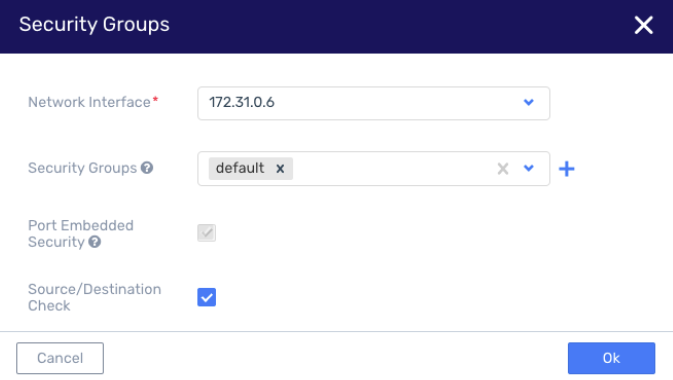
Improve VNC console security¶
Starting of R7 version, users must explicitly allow Zadara administrators or MSP administrators to connect to the VM VNC, otherwise only users from the same project can access the VM VNC.
Auto-populate instance name as a DNS record¶
When creating a new instance from the Management user interface, the DNS name field in the VM creation wizard will auto populate the VM name as the DNS name.
VPC deletion wizard¶
A VPC is a construct with many sub resources and/or attached resources. A VPC deletion wizard was added to easily delete a VPC and it’s related resources as long as there are no running workloads in the VPC.
Allow user to set VPC as default VPC¶
The user is now able to change the default VPC by setting a new VPC as the default one.
Additional changes and bug fixes¶
NK-1103 - Clone image operation to allow creation of an image with IDE devices or extra data disks
NK-1082 - Add the option to export filtered event list to CSV from the management user interface
NK-1108 - Delete project now deletes all the default resources created with the project
NK-797 - Fixed an issue where Compute Overview’s “Top VMs” sort worked only with CPU
Version R5 (V21.1.0)¶
NK-227 - Managed resources (like: ENI, EIP, Security Groups,etc…) are now hidden by default and need to explicitly toggle to see them in all views
NK-294 - Added a capability to the GUI to change Direct Network IP addresses allocation pool
NK-470 - An issue if a wrong error when extending volume on a live instance was resolved
NK-502 - VM snapshots are now restored to the requested pool
NK-594 - MFA is now supported using authenticator application on a mobile device (e.g. Google Authenticator), for both Console and CLI login
NK-771, NK-777 - The system now allows admins and tenant_admins to create instance types and also specify the CPU topology over sockets
NK-795 - A network mini-graph was added on the nodes list view
NK-809 - Added clear indication and system alarm to the cloud admin when running out of EIP per IP pool
NK-831 - Prevent deletion of ENI from the GUI
NK-865 - Ability to export filtered lists as CSV file was added to all GUI tables
NK-897 - GUI and Sym/AWS web shell now work even if firewall is forwarding different public port to 443
NK-904 - Snapshots and volumes are now deleted when deleting image from the marketplace
NK-906 - Tenant Admin gets all the permissions of a member
NK-913 - Images and Marketplace Images now have an Operating system field The Operating system is inherited by the Instances created out of these images
NK-955 - The reboot button was removed from the instance view
NK-967 - A new inspector command was added that can be used to validate the MTU of all network interfaces after changing the MTU in the cluster
Version R4 (V5.5.4)¶
Improvements to the VM Creation dialogue¶
NK-733 - Instance creation wizard Steps are according to functionality
Step1 - Compute
Step2 - Storage
Step3 - Network
Step4 - Config
Show the VPC virtual router IP on the direct subnet¶
NK-668 - It is, now, easier to set the static routes in the external routers in case that VMs on non direct VPC subnets need to be accessed via the direct subnets or need to access entities on the direct subnet that are outside of the direct subnet allocation pool
Additional changes & bug fixes¶
NK-234 - An issue, where direct-network was not listed as route in route-table, was fixed
NK-444 - Improved Resource Consumption tile to make it easier to understand
NK-546 - create default VPC operation was added to the GUI
NK-621 - When attaching Elastic IP, if there is only one network available, it’s now selected automatically
NK-648 - The issue of Load Balancer creation with elastic IP that belong to an instance was resolved
NK-661 - Basic event filtering was fixed, and now working as expected
NK-663 - Project delete is now possible even if a NAT gateway still exists in the project but in a deleted state
NK-681 - AWS compatible API now support import from snapshot
NK-703 - CoreDNS VMs removed from the network topology diagram. Clicking the VPC shows if DNS is enabled
NK-729 - When creating key pair for a VM the keys are automatically download, to prevent inaccessible instance
NK-730 - Neokarm Policies were renamed Symp Policies
NK-739 - Cleanup of aging images from the marketplace
NK-800 - The “default” security group is properly displayed even if a load balancer is configured in the same VPC
Version R3 (V5.5.3)¶
New VPC creation wizard¶
A wizard was added to assist you with creating the 3 common topologies of VPCs with private or public subnets
The Wizard can activated from the Quick Start and from the VPCs pane
Elastic Network Interfaces¶
A new screen was added to manage Network Interfaces. Network interfaces may be attached and detached from an instance and may even move between instances or be a route target. Until now, you could only create it implicitly when connecting an instance to a subnet. Now it has its own screen that exposes the full functionality.
A user can now Create/attach/detach/add security groups and update the name of any network interface.
Toolbox¶
A VM with client tools available on the marketplaces Toolbox v5.5.0. The images contain the Symp CLI, AWS CLI, Python 2.7, Boto3 and Terraform. The instance should be created with an SSH key pair.
Additional changes & bug fixes¶
NK-386 - Added Storage Pool update mechanism
NK-405 - The GUI was fixed to allow subnet name change
NK-422 - The GUI was fixed to enable detach security groups from a network interface
NK-467 - Account members can now generate Access keys
NK-468 - All the networking related tabs are now merged into the networks tab Under instance view. EIP, Security groups and Interfaces operations are done from the same place.
